How often have we come across businesses which have had enviable success and are lost into oblivion now? Take for example, the downfall of Blockbuster with the rise of Netflix, Kodak’s failure with the rise of digital photography or the shutting down of Orkut with Facebook flourishing. All the above examples come from completely different industries, but one thing remains constant – businesses’ failure to understand consumer needs and adapting to change.
So what does this mean for enterprises today, in the era of data deluge and digitization?
With the unlimited amount of data about consumers, it might seem obvious that businesses have more than enough information to understand what the consumer exactly wants. And, that is true to some extent. That is why prudent businesses are not just reshaping their business processes but also business models.
This understanding has lead to the emergence of three kinds of business transformation –
1. Product companies transforming into Product & Services
Pure product companies are transforming to offer services and ecosystems to extend their offerings. For instance, companies like Daimler and BMW picking the pulse of the sharing economy pro-consumer of today and getting into car rental businesses or Phillips transforming from home lighting solutions to a provider of connected systems.
2. Service companies adding products to their portfolios
Service companies are going beyond their niche and launching their own products. For instance, e-commerce giant Amazon launching suite of products like Amazon Echo, Kindle and Fire Stick.
3. Customer oriented ecosystems
More and more businesses are realizing the value of creating a consumer environment where they can offer delightful experiences to their patrons. For instance, brick and mortar retailers opening up their online portals or using technologies like AR/VR and Artificial Intelligence to augment the retail experience and e-commerce players opening their physical stores are examples of businesses trying to create ecosystems that are consumer-oriented and simplify their lives while providing them a delightful experience.
While we are seeing a profound change in the way the business landscape is reshaping owing to digitization and the lines between products, services and environments are getting blurred, is that enough?
Today’s consumers seek seamless and connected experiences. Imagine a well-designed e-commerce platform with an awry checkout process. The customers will not mind abandoning the platform at the very last step, never to come back again. In fact, a complicated checkout process is one of the topmost reasons for cart abandonment on e-commerce portals.
The realization that all businesses, whether B2B or B2C are H2H (Human to Human), is imperative for organizations to build relationships with customers and Design Thinking fills the gap of the human element.
Design and Design Thinking are often confused as the same term, and that is far from true. There is a difference between Design and Design Thinking. Former is mostly misunderstood to be limited to how things look, the graphics and design element. Usability and ‘how it works’ has been the hallmark of good design for ages – even before the term Design Thinking was coined.
A good design is about creating a solution that is intuitive, anticipates the latent needs of the consumer and is future ready and thus, Design Thinking is much more than just incorporating great graphics into a product and making them look attractive.
“Most people make the mistake of thinking design is what it looks like. People think it’s this veneer — that the designers are handed this box and told, ‘Make it look good!’ That’s not what we think design is. It’s not just what it looks like and feels like. Design is how it works.” — Steve Jobs
Design Thinking is a human-centered, iterative design process consisting of 5 steps—Empathize, Define, Ideate, Prototype, and Test. It is useful in tackling problems that are ill-defined or unknown. Design Thinking is a concept that can simplify consumer journey and add value across industries and functions.
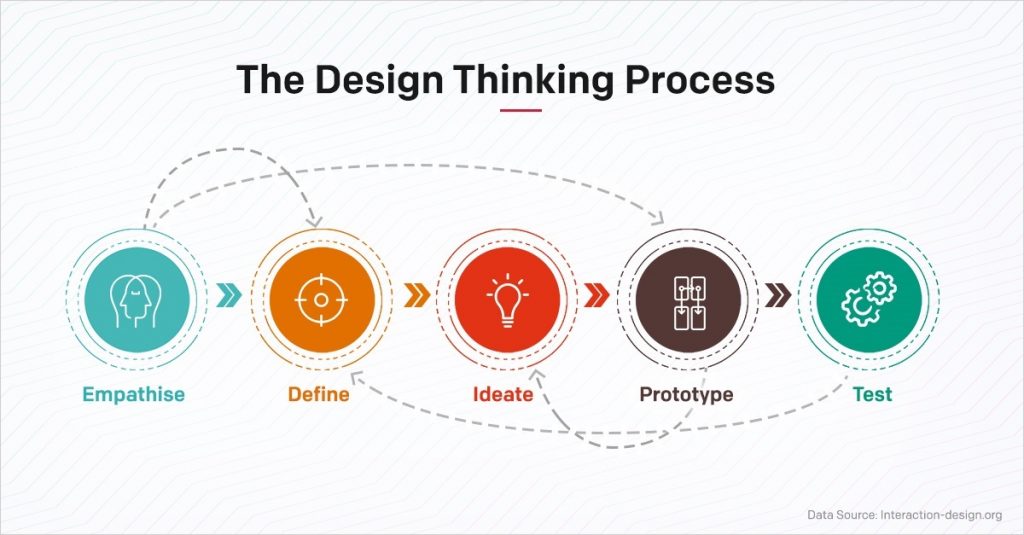
Take for example IBM created billboards their IBM’s People for Smarter Cities initiative. The billboards acted as ramps, benches, or rain shelters. Such a simple yet effective idea!
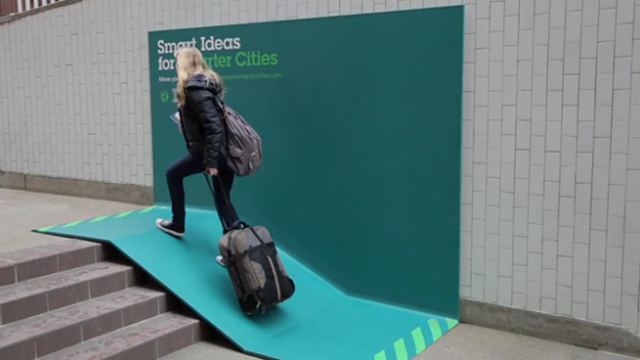
Image Source
Another hallmark of striking the right human chords and creating delightful customer experience through Design Thinking approach is the story of Doug Dietz from GE healthcare creating Adventure series MRI machines for children.
Doug Dietz was an industrial designer, working for GE Healthcare. When the first time he saw a little girl who was crying on her way to a scanner that was designed by him, the horror of the experience struck him. Doug reminiscences:
“The room itself is kind of dark and has those flickering fluorescent lights”, he adds in his TED talk “that machine that I had designed basically looked like a brick with a hole in it.”
Inspired by the principles of Design Thinking Doug created the ‘Adventure series MRI machines’ which reformed the horrid experience of going through the scanner to an enjoyable one.
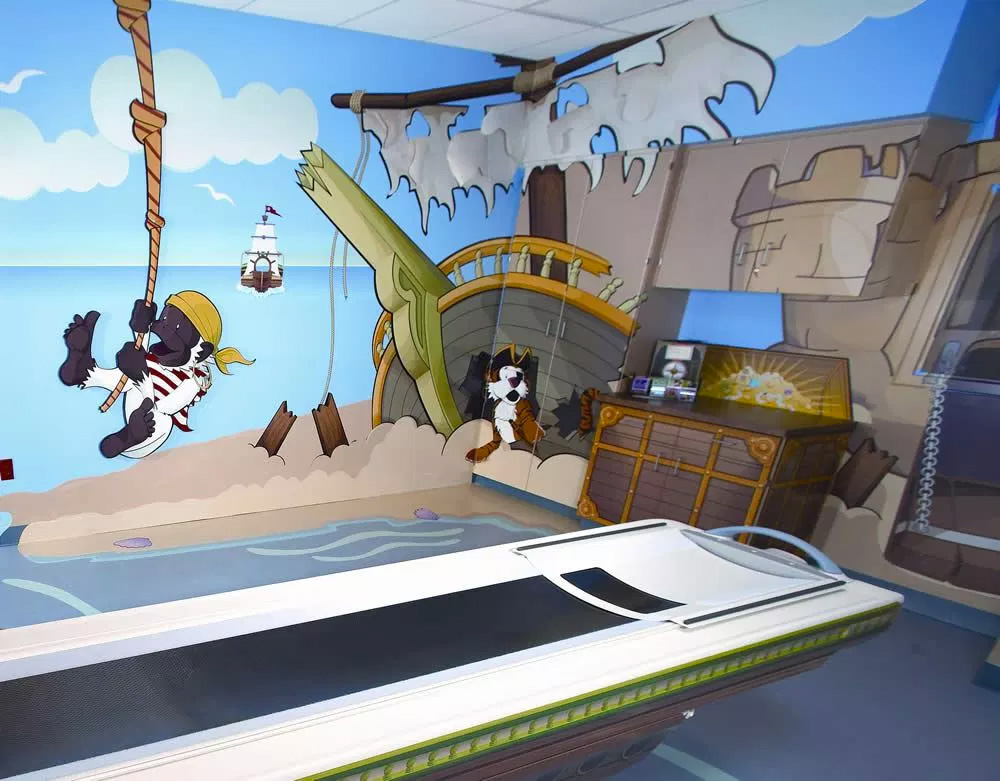
Image Source
As rightly said by our CEO Ravi Teja Bommireddipall
‘’Customers cannot always articulate what they want; they can tell you their pain points but meeting the latent needs of customers from those pain points is where real innovation happens. To understand these latent needs, it is crucial for entrepreneurs and product innovators to empathize with their customers. This will only be achieved when we step into the customers’ shoes and live with them, and that cannot happen inside an air-conditioned office, looking at a heap of data. I call this GOOB – go out of the building, and live with your customers.’’
For instance, McDonald’s India wanted to make their mobile app the preferred medium for ordering. The vision was to bring the emotions of joy and delight from in-store to the new McDelivery app experience. We made several store visits, observed the customer, identified their pain points and crafted an app that delighted the customers. The new app was able to garner 103% more orders than the older one.
So what is the role that Design Thinking plays in creating a delightful end-to-end customer experience?
In a digital world, the competitive landscape is flattened and the barriers of entry are low. Businesses are continuously reinventing themselves to meet the demand of the new age consumer.
Uber disrupted the transportation industry, without owning any cars but with a well-designed intuitive app. Airbnb disrupted the hospitality industry by upgrading a simple idea of room sharing into a well-designed website and mobile app. These enterprises testify that having innovative ideas isn’t enough capitalizing on that idea with the help of exceptional design and intuitive user experiences are the key to success.
In the digital era, where customers are empowered by information and are spoilt for choices it is imperative for businesses to add elements of design at the heart of every brand experience.
By design, these experiences elevate the consumption of personalized content and experiences at every touchpoint. Design-led organizations like Apple or IKEA realize the contribution of human-centered design in crafting engaging customer experiences and eventually to the growth and ROI of an enterprise. Hence, Design Thinking is at the heart of their strategies.
Key aspects of creating design-led customer experiences
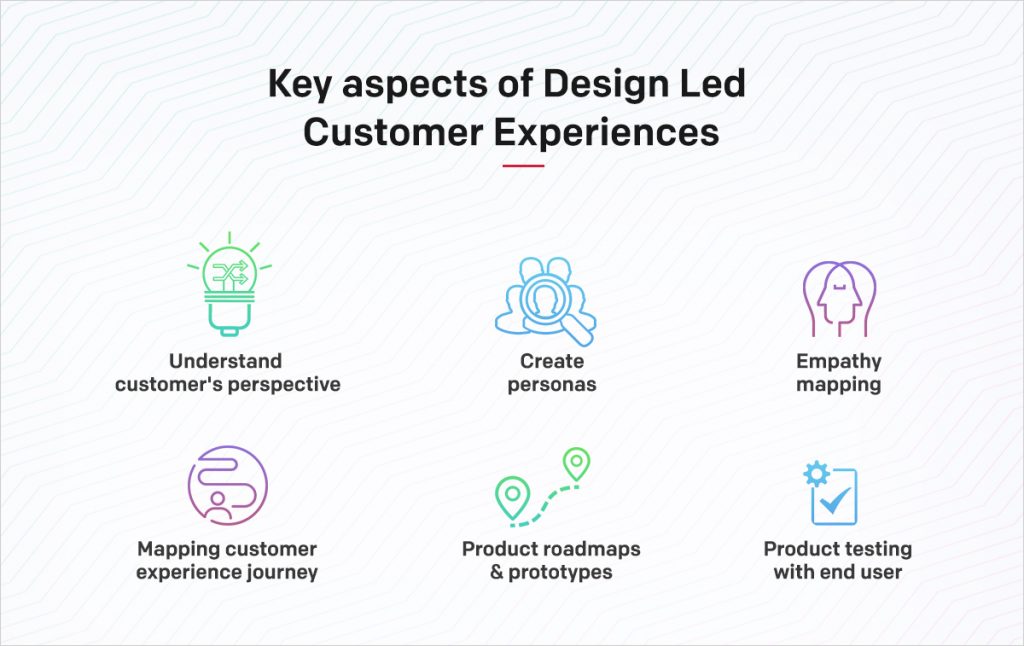
1. Understand the customer’s needs and perspectives
For most businesses innovation is approached from a technological point of view. However, the Design Thinking approach is about keeping the consumer’s perspective first. Understanding and resolving core consumer pain points will lead to a product that is consumer oriented and offers a delightful experience to them.
2. Create Personas
As quoted by our CEO Ravi in this article
“Know thy customer” is a familiar term to marketing and sales executives. Yet marketers who don’t take the steps necessary to better understand their customers will not be successful. Regardless of how you gather information about customers, it’s imperative that you use the information as a basis for understanding what makes the customer tick.’’
By developing personas of the customer base, businesses can come closer to the psyche of the consumer. Once businesses empathize and understand the consumer profiles, they will find a better way to not just connect with them but add value to the experience. The persona should include an image of the imaginary customer, demographic profile, attributes and motivations, needs, pain points, and actual customer quotes.
3. Empathy mapping
Empathy mapping is a collaborative process to gain deeper insights about consumers. An empathy map can represent a consumer segment and can provide a complete picture of the customer and what actions they might take as a result of their beliefs, emotions, and behaviors. Empathy mapping has 4 quadrants labeled as ‘think’, ‘feel’, ‘say’, ‘do’ to help make sense of different aspects of the customer’s experience and preferences.

4. Mapping the customer’s experience journey
Businesses today have a plethora of customer touchpoints digital and offline and hence enough data to understand the consumer. However, they continuously struggle to understand customer motivations and influences. This is where customer journey maps help.
Customer journey maps enable businesses to understand the consumer needs and hence build relationships by solving for those at every touch point. According to a research, customer journey maps improve marketing return on investment by 24 percent and shrink sales cycles by 16 percent. A great customer journey map should articulate an ideal customer experience and act as a guide for businesses to deliver that. According to a study from Adobe and Econsultancy, companies with a focused, customer-first approach are more than twice as likely to rise above competitors.
5. Create product roadmaps and prototypes
In today’s world; customer needs, market forces, and innovation across industries are reshaping the customer experiences continuously. It is imperative for businesses to adopt an Agile approach. Hence smart businesses do not go about launching a full-blown product, rather they create an MVP (Minimum Viable Product) which allows them to test, experiment and improve, more often and faster. Creating product roadmaps and prototypes before launching the final product minimizes the chances of errors and leaves scope for further development.
Iterating with customer feedback is an efficient way to create customer experience prototype, these pilots can lead to secure outcomes before scaling the product.
For instance, at Robosoft we partnered with Athenahealth, they had developed a medical reference app that doctors were using to check interactions between drugs. The problem was that the doctors didn’t find the app very useful. Based on the feedback from the doctors, the app was redesigned to include sponsored and original personalized content. The redesigned app with upgraded features helped keep doctors engaged and asking questions or sharing information, not just sending information to the doctor.
Businesses should build processes to manage these prototypes in an Agile way, through sprints and frequent feedback from users, with a focus on developing business value.
6. Product testing with the end user
The end user will not experience the product in a controlled and predictable environment, and hence Product Testing with the end consumer is one of the most essential steps of a Design Thinking process.
Most design driven enterprises have their Design labs where they are in an early phase of user research when products are not ready to be launched into the field, but insights can be drawn by observing how people interact with prototypes for different concepts. Simulated environments are created for users are created to experience the products and then the user interactions are measured with various tools like heat maps, touch maps, screen flows, user analytics platforms, etc.
Challenges in implementing customer experiences using Design Thinking
While using Design Thinking to build customer experiences seem like an easy solution, it is easier said than done. It is more than just a cognitive shift, there are organizational and business challenges that need to be met. Some of them are:
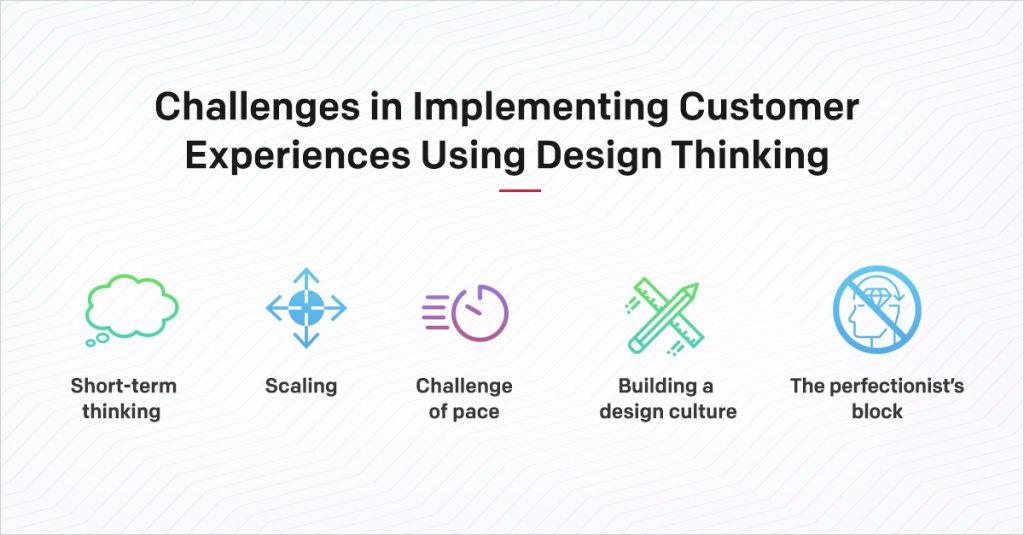
1. Short-term thinking
Manier times enterprises see Design Thinking as a short term approach to a particular project or a product. In a world where technology is changing consumer experiences and needs every single day, a short-term approach and vision will not help in yielding the best results out of the Design Thinking strategy. Business leaders have to think about the entire ecosystem where the consumer exists and the future before defining their strategy. By starting small but thinking big enterprises can work towards a successful Design Thinking strategy. Take for example, Paytm which started as a mobile recharge platform to one of the largest mobile payments platform with over 7 million merchants and 300 million registered wallet users, and now a major e-commerce platform. Paytm couldn’t have done all this without envisioning and keeping a pulse of the changing ecosystem around the consumer, and working with a long-term goal around that.
2. Scaling
Given the expanding surface of customer touch points in an always-accessible and always-on era, scaling the Design Thinking approach to every touch point can be a daunting task for businesses.
3. Challenge of pace
Today, global brands have to address and engage with customers and offer a personalized experience to tens and thousands of customers at a time. Which might need technology and access to a huge amount of data and process in place. Effective design needs to be efficient, as well as engaging. Not all businesses are equipped to do that at every stage.
4. Building a design culture
As Design Thinking becomes the buzz word in this age of the consumer, businesses will need to align the organization to have a design-oriented approach. Most organizations try to do that in two ways – by either having a team of designers across all their product teams or by creating a design team that rotates among project groups. While organizations have to identify their own approach basis their organizational culture. Each of these approaches might have their own shortfalls for instances having a siloed team of designers for n number of projects may lead to disjointed products as product team’s and design team’s vision might be different. Similarly having an internal consultancy might take up only big projects leaving the minute design gaps to be filled by the product teams. Airbnb has a unique approach to having a consumer-oriented design culture Every project team at Airbnb has a project manager whose explicit role is to represent the user, not a particular functional group like engineering or design. According to Alex Schleifer, product head at Airbnb
“Conflict is a huge and important part of innovation, this structure creates points where different points of view meet and are either aligned or not.”
5. Designers’ and product stakeholders’ perfectionist block
More often than not product stakeholders want to launch a product that is ‘perfect’. However, that is one of the major roadblocks in the Design Thinking approach. Design Thinking approach is iterative, Data and Analytics-driven. In this ever-changing world product managers and enterprises should be ready to launch a Minimum Viable Product and then iterate it basis consumer feedback and data and then scale further in a step-by-step manner.
In conclusion:
The most innovative companies in the world like Apple, Coca Cola, IBM, etc. have one thing in common, they use design as an integrative resource to innovate more efficiently and successfully. According to the DMI index design-led organizations outperform S&P by a whopping 228%. The convergence of technology, business environment and changing consumer preference is opening doors for unlikely competitors as well as newer opportunities. To succeed and take advantage of the opportunities, enterprises will have to adopt an Agile, design-led development process with the continual redesign and understanding evolving of customer journeys.





